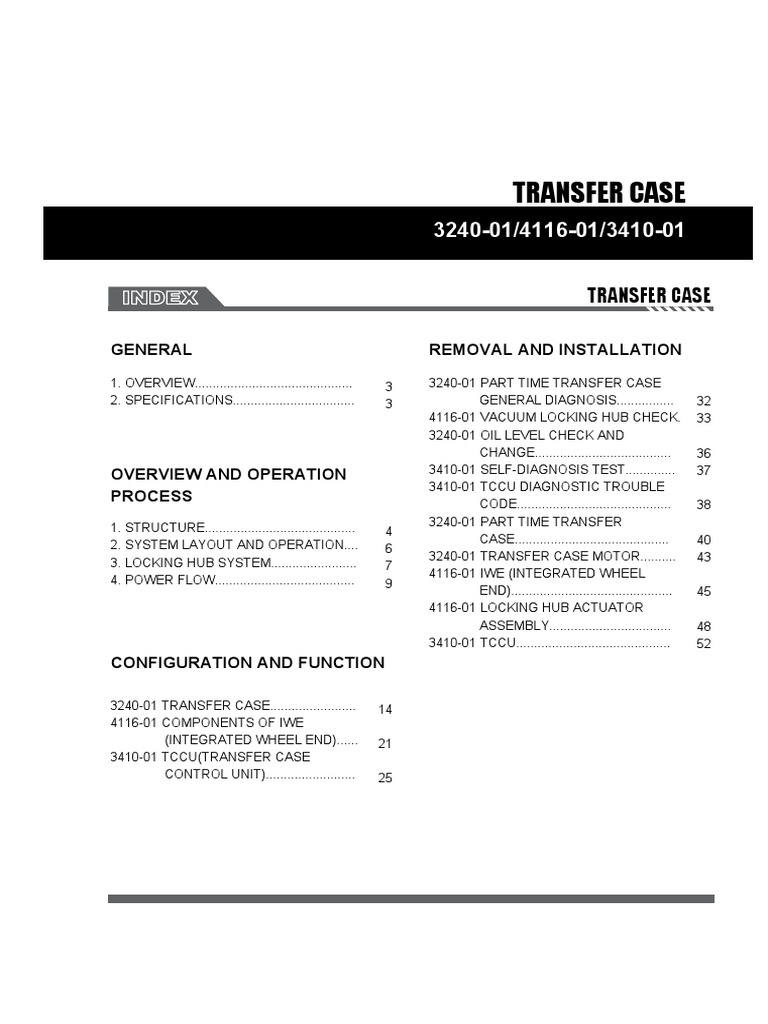The transfer case, a component often shrouded in mechanical mystery, is the unsung hero of four-wheel drive (4WD) and all-wheel drive (AWD) vehicles. It’s more than just a box of gears; it’s the arbiter of torque, the distributor of power, and the key to unlocking a vehicle’s true off-road potential. Think of it as the conductor of an automotive orchestra, ensuring each section (front and rear axles) plays its part in perfect harmony, or, more accurately, in perfect traction. Without a functioning transfer case, a 4WD or AWD vehicle is essentially a two-wheel drive vehicle, stripped of its ability to conquer challenging terrain.
The Fundamental Role: Diverting and Modulating Power
At its core, the transfer case performs two essential functions: diverting power from the transmission to both the front and rear axles, and, in many cases, modulating the distribution of that power. In a rear-wheel drive vehicle, the transmission sends power directly to the rear axle. In a 4WD or AWD vehicle, however, the transmission’s output is routed to the transfer case first. The transfer case then splits this power and sends it to both the front and rear driveshafts. This split isn’t always 50/50. Depending on the type of transfer case and the driving conditions, the power distribution can vary significantly, favoring either the front or rear axle to optimize traction.
Consider the transfer case a sophisticated gatekeeper, strategically opening and closing passageways to control the flow of energy. It’s not merely splitting the power, it’s strategically directing it to where it’s most needed, optimizing the vehicle’s grip on the road, or lack thereof.
Types of Transfer Cases: A Spectrum of Capability
Transfer cases aren’t monolithic entities; they come in a variety of flavors, each designed for specific applications and levels of off-road prowess. Here’s a brief overview of the most common types:
- Part-Time Transfer Cases: These are the traditional workhorses of the 4WD world. Found primarily in older trucks and SUVs, part-time transfer cases require the driver to manually engage four-wheel drive. They lack a center differential, meaning they cannot be used on paved surfaces in 4WD mode due to driveline binding. This binding occurs because the front and rear axles are forced to rotate at the same speed, even when the wheels are turning at different speeds during a turn. The result is stress on the drivetrain and potential damage. Part-time systems offer robust off-road capability but demand a knowledgeable driver who understands when and where to engage 4WD.
- Full-Time Transfer Cases: Unlike part-time systems, full-time transfer cases can be used on any surface, including pavement. This is because they incorporate a center differential, which allows the front and rear axles to rotate at different speeds. This eliminates driveline binding and allows for smoother operation. Full-time transfer cases offer improved traction and stability in a wider range of conditions, making them suitable for everyday driving and mild off-roading.
- Automatic Transfer Cases: These are the most sophisticated type of transfer case, found in many modern AWD vehicles. Automatic transfer cases use sensors and electronic control units (ECUs) to automatically adjust the power distribution between the front and rear axles based on driving conditions. They can detect wheel slip, throttle position, and other factors to optimize traction and stability. Automatic transfer cases offer the convenience of hands-free operation and the benefit of enhanced safety in inclement weather. The driver doesn’t need to consciously engage 4WD; the system seamlessly adapts to changing conditions.
The distinctions among these types are critical. Choosing the right type of transfer case depends entirely on the vehicle’s intended use. A dedicated off-roader might prefer the rugged simplicity of a part-time system, while a daily driver might opt for the convenience and versatility of an automatic system.
Low Range: Amplifying Torque for Extreme Conditions
Many transfer cases, particularly those found in off-road-oriented vehicles, include a low range gear. Low range is a lower gear ratio that significantly increases the amount of torque sent to the wheels. This is invaluable for crawling over rocks, navigating steep inclines, or pulling heavy loads. Engaging low range essentially multiplies the engine’s torque output, providing the extra grunt needed to overcome challenging obstacles. Imagine low range as a lever, providing significantly more leverage to the wheels for when sheer brute force is required.
It’s important to understand that low range reduces the vehicle’s speed dramatically. It’s not intended for high-speed driving; its sole purpose is to provide maximum torque at very low speeds. Think of it as shifting into first gear on a bicycle when tackling a very steep hill; the effort required is reduced, but the speed is also significantly lower.
The Role of the Center Differential: Managing Torque Split
The center differential, present in full-time and automatic transfer cases, is a crucial component for ensuring smooth and safe operation on all surfaces. As mentioned earlier, it allows the front and rear axles to rotate at different speeds. This is essential when turning, as the outer wheels travel a greater distance than the inner wheels. Without a center differential, the drivetrain would bind, causing stress on the components and potentially leading to damage.
Furthermore, the center differential can also be used to manage the torque split between the front and rear axles. Some transfer cases use viscous couplings or electronic clutch packs to limit the amount of slip in the center differential, effectively sending more torque to the axle with the most traction. This helps to improve stability and prevent wheel spin in slippery conditions.
Maintaining the Transfer Case: A Proactive Approach
Like any mechanical component, the transfer case requires regular maintenance to ensure its longevity and optimal performance. The most important maintenance task is checking and changing the transfer case fluid according to the manufacturer’s recommendations. Low fluid levels or contaminated fluid can lead to overheating, wear, and eventual failure of the transfer case. It’s also important to inspect the transfer case for leaks and to address any issues promptly.
Neglecting transfer case maintenance can be a costly mistake. A damaged or failed transfer case can leave a vehicle stranded and can require expensive repairs. A little preventative maintenance can go a long way in ensuring years of reliable performance.
In conclusion, the transfer case is a complex and vital component that enables the capabilities of 4WD and AWD vehicles. From diverting power to modulating torque split and providing low-range gearing, the transfer case plays a crucial role in optimizing traction and performance. Understanding the different types of transfer cases and their functions is essential for choosing the right vehicle for your needs and for ensuring proper maintenance and operation. It’s the intricate nexus where power meets purpose, transforming a standard vehicle into a terrain-conquering machine.








Leave a Comment